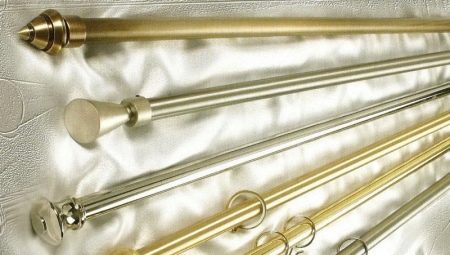The kitchen is a sacred place for many people. It is there that households most often gather to have breakfast, dinner, or just have tea together, discussing the accumulated problems at the same time, or, conversely, to share a joyful event. And it is precisely there that guests are most often invited, since in modern houses and apartments the kitchen and living room are often combined, not fenced off by a blank wall. Therefore, most people seek, as carefully as possible, to arrange this room, where the cornice plays a rather significant role.
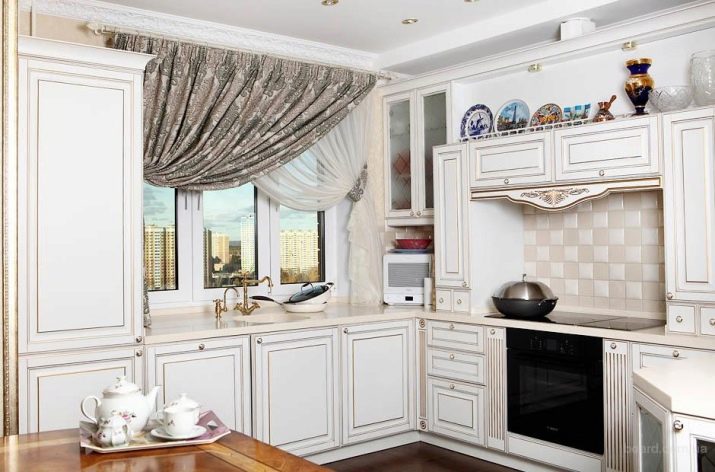
Features
A cornice is a necessary element of decor for almost any room. It is designed to beat the window opening as best as possible, to emphasize the style of the room and, of course, serves as support for curtains and tulle. A cornice for a kitchen always adds comfort to the surroundings, because curtains and tulle cannot be hung without it, which means that the situation as a whole will seem uncomfortable and more official.
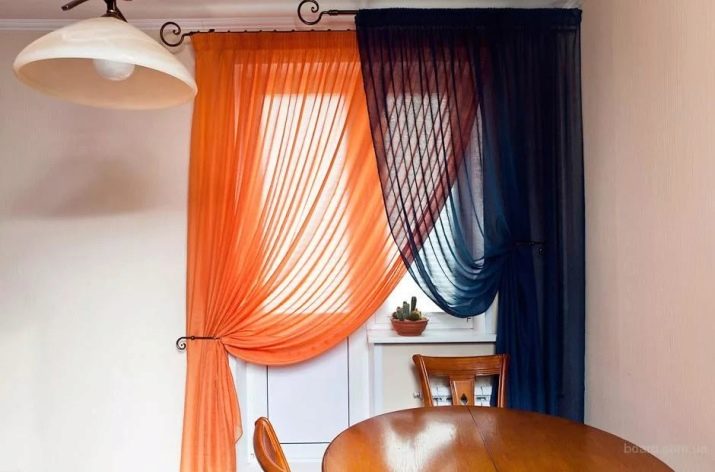
Kitchen items, depending on the design features, are usually divided into several types. Depending on the number of suspended paintings, cornices are divided into single-row, two-row and three-row. There are also four-row species, but they are usually not used to design kitchen openings. On single-row cornices you can hang light curtains or tulle. The two-row type of cornices is suitable for two-layer compositions, consisting, as a rule, of curtains and tulle. Three-row types allow you to simultaneously place curtains, tulle and lambrequin.

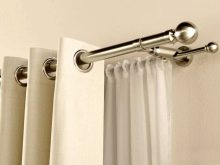
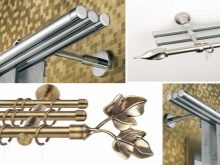
According to the design features, the cornices are divided into round (bar) and profile. On the rods, the curtains are held with the help of freely sliding rings, the diameter of which significantly exceeds the diameter of the rod. Rings can be inserted both into the fabric itself and attached using hooks. In the profile cornices, the curtains are held by hooks, one end of which moves freely along the inner path, and the other holds a small loop of the curtain.
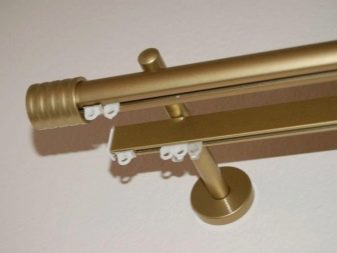
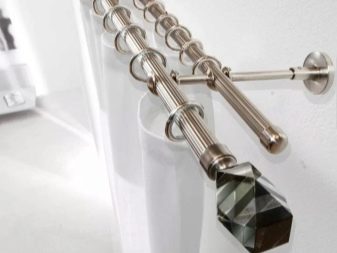
Profile types, depending on the purpose, are divided into straight and flexible cornices. The latter are suitable for creating a curved suspension line. Most often they are used in rooms with bay windows. The design of profile cornices can be both open and decorated with a panel. Moreover, the panel can be present not only on straight lines, but also on flexible cornices.
The bar not only perfectly hides aesthetically unattractive hooks, but also is a harmonious continuation of the cornice.
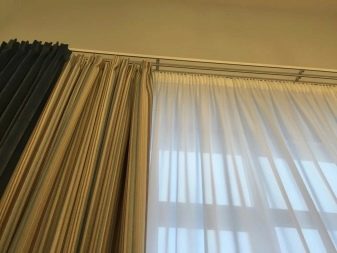
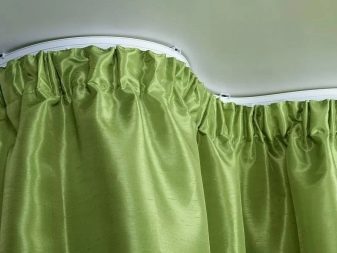
Kinds
Today there are many different types of kitchen cornices, differing also in style.
- The most common form is, of course, open rod cornice. It will fit perfectly into almost any kitchen, regardless of the style of decoration, the main thing is to choose the option that suits you. Most often, an option is selected in the kitchen, consisting structurally of one or two bars, at the ends of which there are always tips corresponding to the style. These types of cornices are attached either to the ceiling or to the wall. The wall-mounted version is used more often, because it visually looks better, since the corners on which 1 or 2 rods are mounted are hidden.
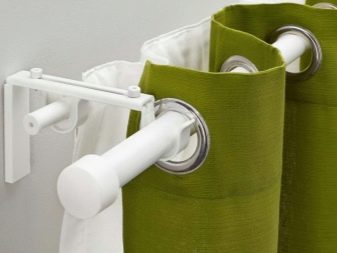
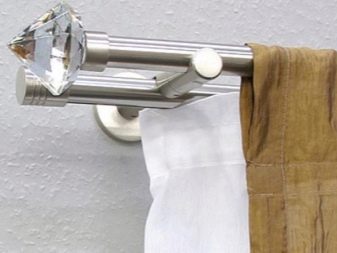
- String cornice is an equally popular view among cornices. Its device is almost similar to the rod, the difference is only in the thickness of the part holding the curtains. Between the two corners, instead of the rod, there is a strongly stretched string, both ends of which are quite firmly fixed and do not protrude beyond the fasteners.
This type is suitable only for light curtains like tulle or fabrics with a low density, because the string is thin and therefore the “heavy” curtains will not hold, sag or tear.
The curtains on a string instance are held most often with the help of eyelets - rings fixed to the fabric. This view is more suitable for kitchens decorated in the style of hi-tech and minimalism. In addition, they are perfect for decorating narrow window openings.
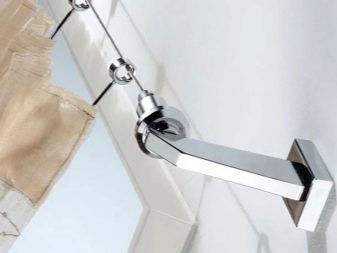
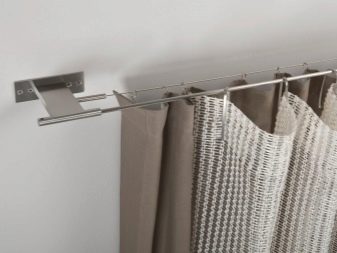
- For kitchens in the Provence style and with a classic design, perfect stained glass (telescopic) cornice. It will not take up much space, since it is mounted either directly on the frame or between the side surfaces of the window openings. This type is a type of single-row rod cornice, since its basis is a rod fixed with special fasteners between two brackets. When installing the cornice on the frame, the mounting method may vary, some manufacturers produce instances for fixing which a more gentle method for the surface is used, namely double-sided tape.
A rather striking difference between this type and the rod cornice is the possibility of increasing its length due to the extension of the main rod. The pipe, like a telescope, extends to the desired length, so it is unnecessary to calculate up to 1 cm the width of the opening, which is undoubtedly a huge plus.
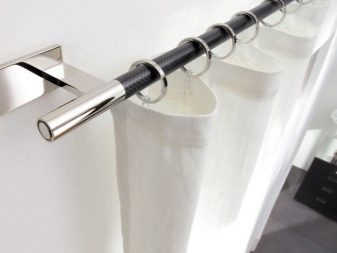
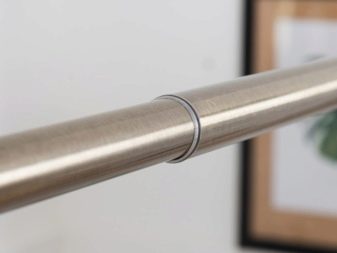
- Tire (profile) eaves in appearance it resembles the letter P. Inside the profile strip there are recesses similar to the tracks along which the hooks move. The ends of the tire may have either straight or rounded edges. The latter type is most often equipped with a decorative strip, so such cornices are often called baguette. The mounting method of this type depends on the design solution. Most often, curtain rails are mounted on the ceiling surface, but you can also find options that are perfectly mounted on the wall. This type is also often used as a hidden option in a stretch ceiling.
The profile cornice is suitable for large wide windows with deep openings. This type of cornice will look great in a bright large kitchen, combined with a loggia.

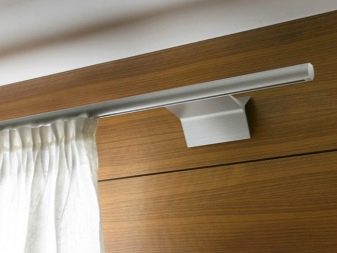
- Electric cornice It is a variety of tire type, but only in contrast to the latter, this option has a more complex design and more modern appearance. In the side of the cornice is a motor that allows you to move the curtain panel without the application of manual force. Management of this cornice is carried out using the remote control or application in the smartphone.
It is indispensable for rooms with inaccessible location of window openings, as well as for kitchens in which the window has a non-standard shape.
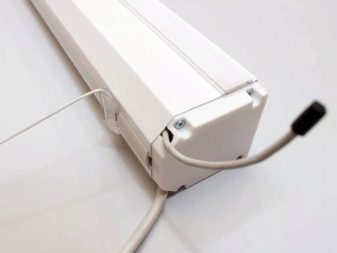

Important! A simpler option for a kitchen with non-standard window openings is a flexible cornice. It is often installed under a suspended or suspended ceiling with fixation both on the wall and on the ceiling, which has not undergone reconstruction.

Materials
The species variety of cornices allows each buyer to choose an option according to the style of the kitchen. The combination of the design of the cornice with the elements of the decor of the kitchen is undoubtedly important, but it is worth considering the material of manufacture, since finding the version of the cornice you like in different materials is not a problem today. Metal, plastic or wooden structures have both advantages and disadvantages that must be considered when choosing.
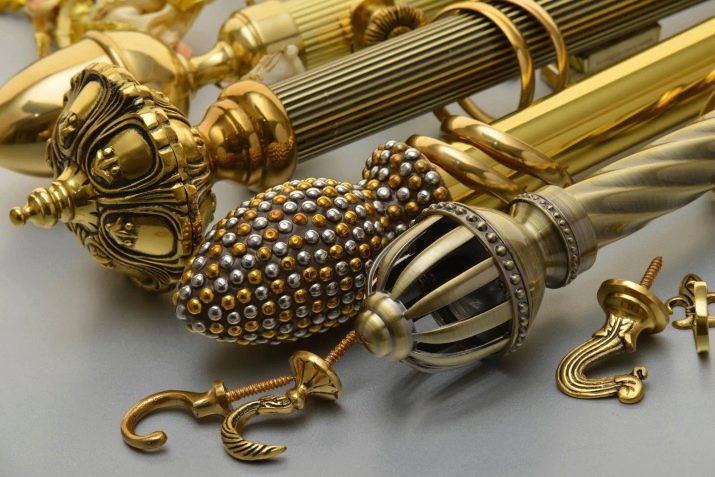
Let's consider them in more detail.
- Metal cornices durable, not afraid of temperature changes and resistant to chemicals used to clean them. In addition, they are perfectly combined with many styles, because on sale you can find a wide variety of color solutions, as well as design.
The only drawback of these products is their high price.
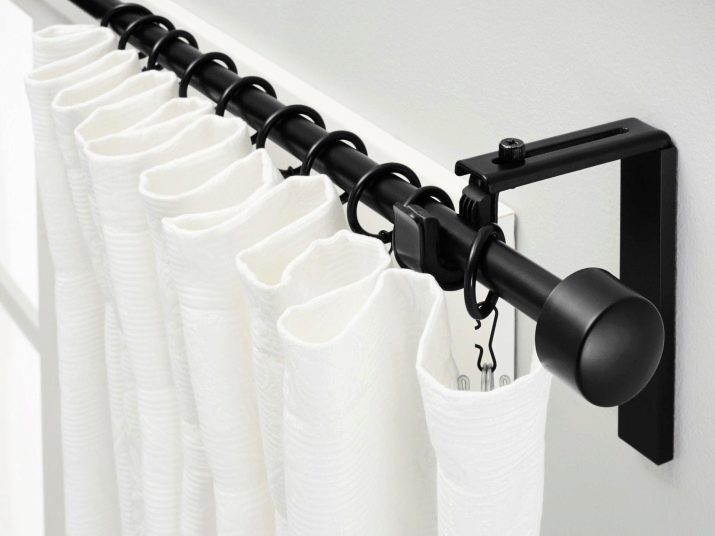
- Plastic cornices belong, perhaps, to the most popular options. Plastic is exactly the material from which the most modifications and color solutions are made. Plastic options are resistant to moisture, chemicals used in washing, and are not subject to fading. Although the life of the plastic structure is quite long, and they cost much less than metal copies, such products also have their disadvantage - a low degree of strength.
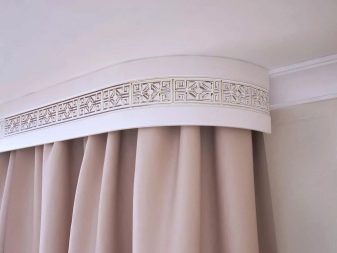
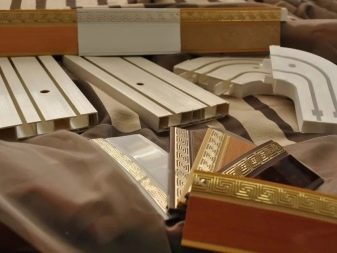
- Wooden cornices less popular for many reasons. Although the material is environmentally friendly, it is coated with a special composition to increase its useful life, but still it cannot be called too stable. Wooden products do not tolerate high humidity, temperature fluctuations and exposure to chemicals when washing. They need excellent ventilation and very gentle care, which is time consuming and time-consuming, so wooden cornices are rarely installed in the kitchen.
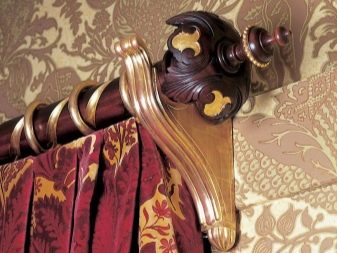
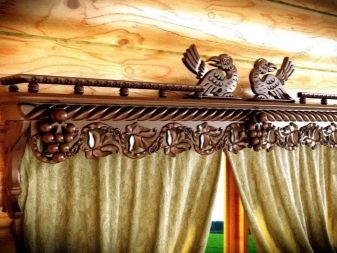
Selection tips
The correct choice of the cornice is the key to a good mood, therefore it is so important when choosing the option not to be mistaken with the texture or design of the product. Everything will have to be taken into account: the design of the room, its size, and the density of the curtains, and, of course, not to forget about the practicality of the chosen option. It is worth paying attention to some tips.
- Barbell eaves Look great in a hi-tech or classic kitchen. They do not overload the environment and are perfectly combined with home decoration. But when choosing, you should avoid options with elaborate tips and ornate rods, as options with a simple decor and smooth texture are more suitable for these styles. In addition, it is somewhat more difficult to care for such a cornice than for a product that is simpler in decor and smooth in texture.
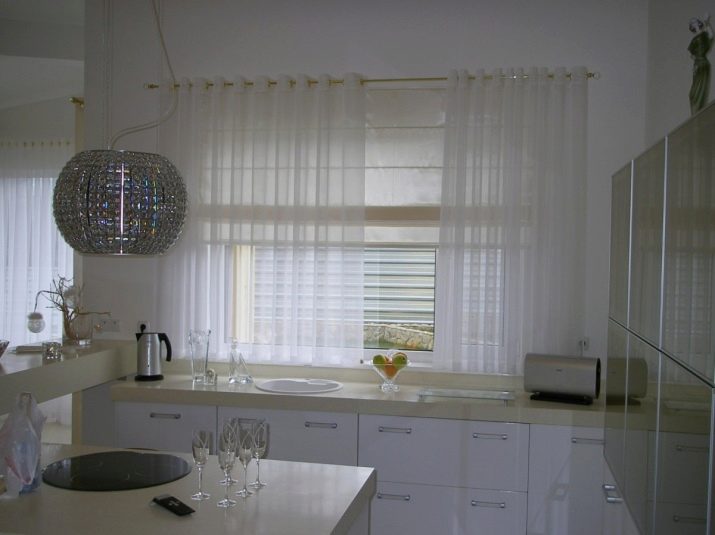
- For kitchens decorated in the style of Provence or country, simple, of course, are more suitable. wooden eaves not overloaded with details. But you can also hang plastic ones, since on sale you can find options with imitation of wooden texture.
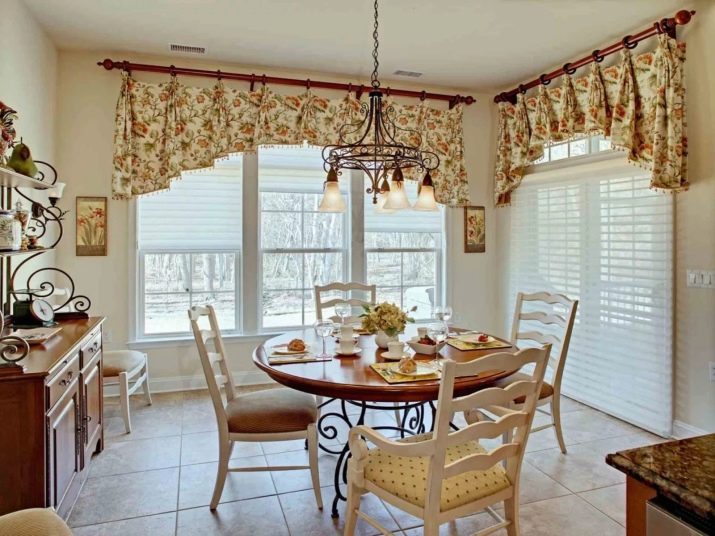
- When choosing, it is worth considering curtain density. Metal products can withstand a significant weight of the curtains, which, of course, is important for rooms located on the ground floor, as well as for those that are too close to neighboring buildings. The only exception is metal string cornices, they can withstand only thin, almost weightless fabric.
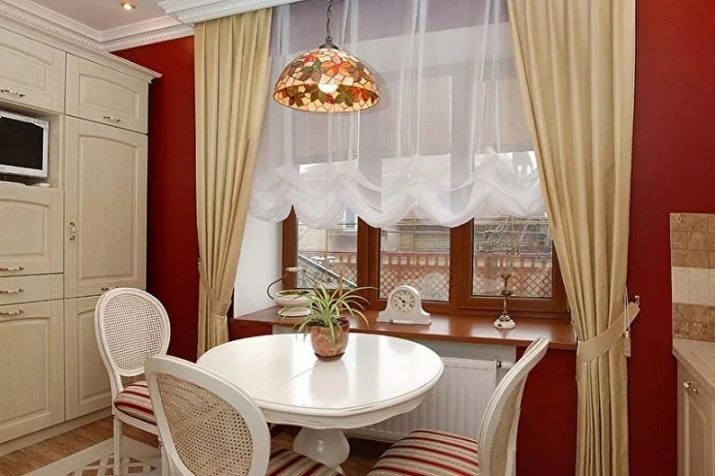
Ceiling-mounted plastic curtain rods contribute to the visual increase in the room. This is especially important if the ceilings in the kitchen are no higher than 2.5 m. If the ceilings are high or the visual perception is not so important, then you can stop on other options.
A telescopic curtain rod is a good solution for a small window with a sink located in the lower zone.
So the tulle, and most often they hang it, will not interfere, but at the same time the window will be closed from prying eyes.
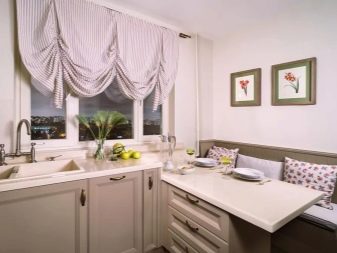
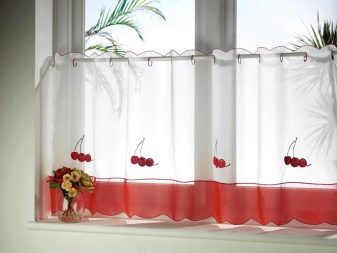
- Flexible profile cornices Look good in kitchens with a balcony door, with panoramic or wide windows, as well as in rooms where the walls have a semicircular shape. They perfectly fit into any style and perfectly decorate arched, lancet, angular and bay windows.
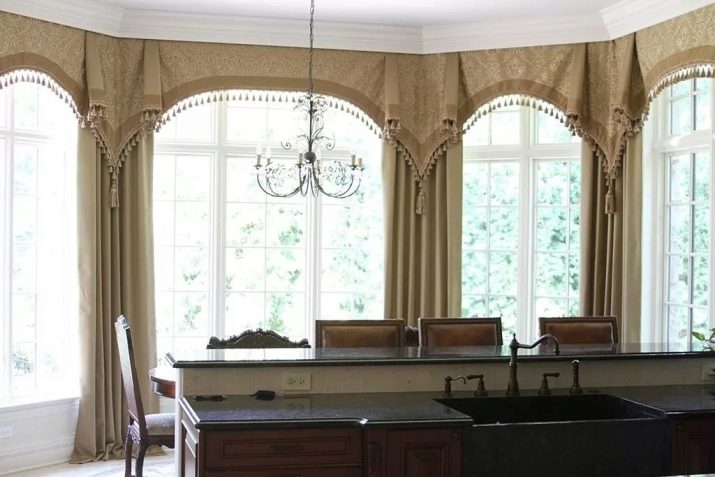
How to fasten?
Both the visual perception and the life of the product depend on how and in which place the cornice will be fixed. Almost any kind of cornice is fixed either on the ceiling surface or on the wall.
Both that and another way are equally good, the main thing is to choose the fasteners correctly and not to use the used bolts, brackets and other details necessary for installation.
It is necessary to take into account both the type of surface on which the selected version will be attached and the length of the product. The longer the cornice, the higher the likelihood that additional fasteners are required. Especially this rule applies to metal products and cornices, on which heavy curtains will hang.
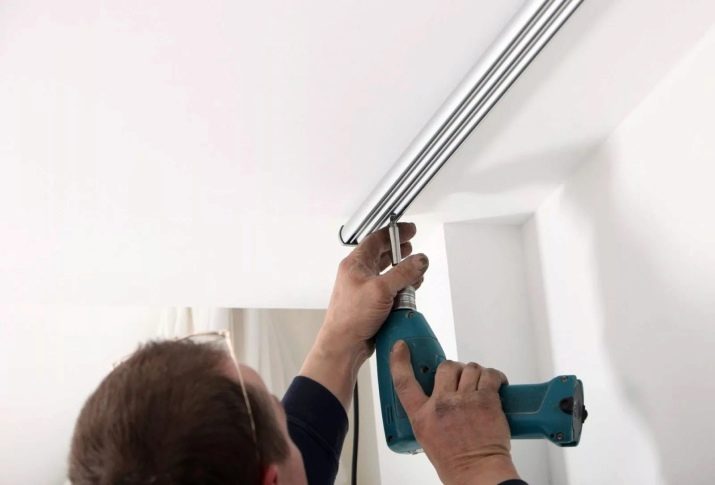
The standard calculation of the required length of the cornice is reduced to measuring the width of the window opening, to which is added from 25 to 40 cm. But if you need to visually expand the window opening, then the margin in length given above can be increased. To visually reduce the width of the window, the cornice is selected with a smaller margin in length, in this case, the numbers vary within 15–25 cm. For mini options installed on the frame, the length should always be equal to the width of the frame.
The design of the cornice should be higher than the window frame, the minimum gap is 5 cm. The minimum distance from the wall, regardless of the method of fastening, should be at least 10 cm.

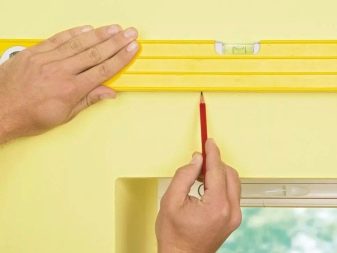
Regardless of which mounting method was chosen, the cornice should be installed not only in the right place, but also well fixed. Otherwise, at best, he will not be able to hold the curtains, but at worst he will simply fall.

In the next video, you will learn how to choose the right curtain rod for curtains.
